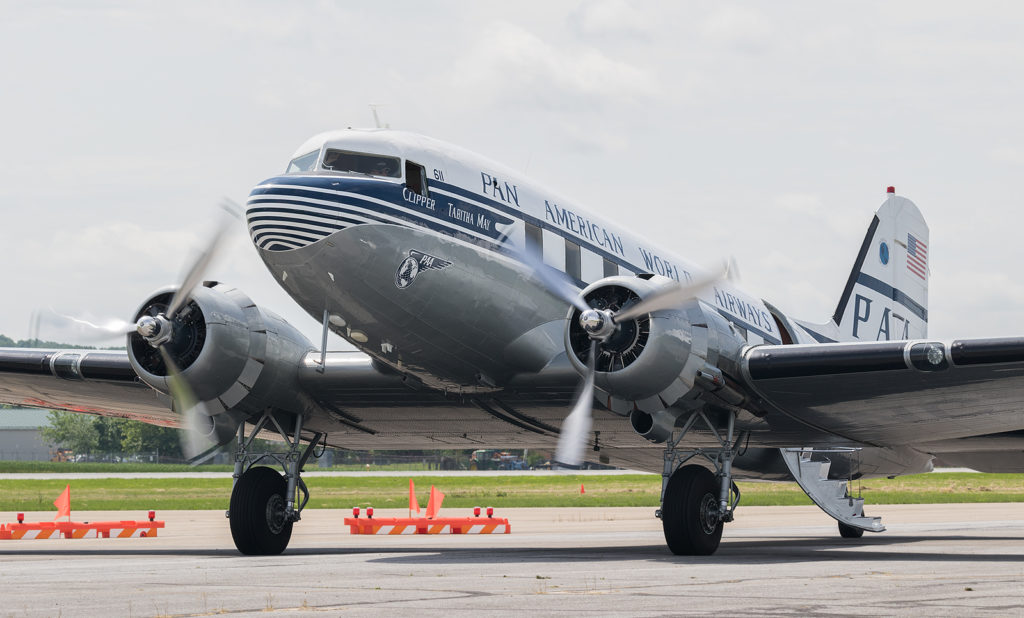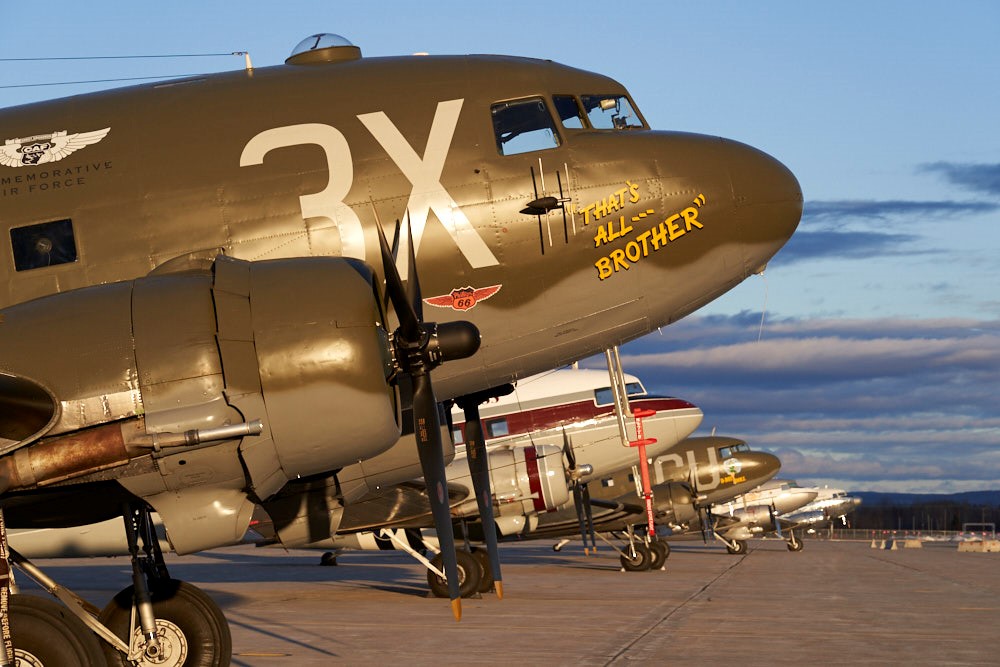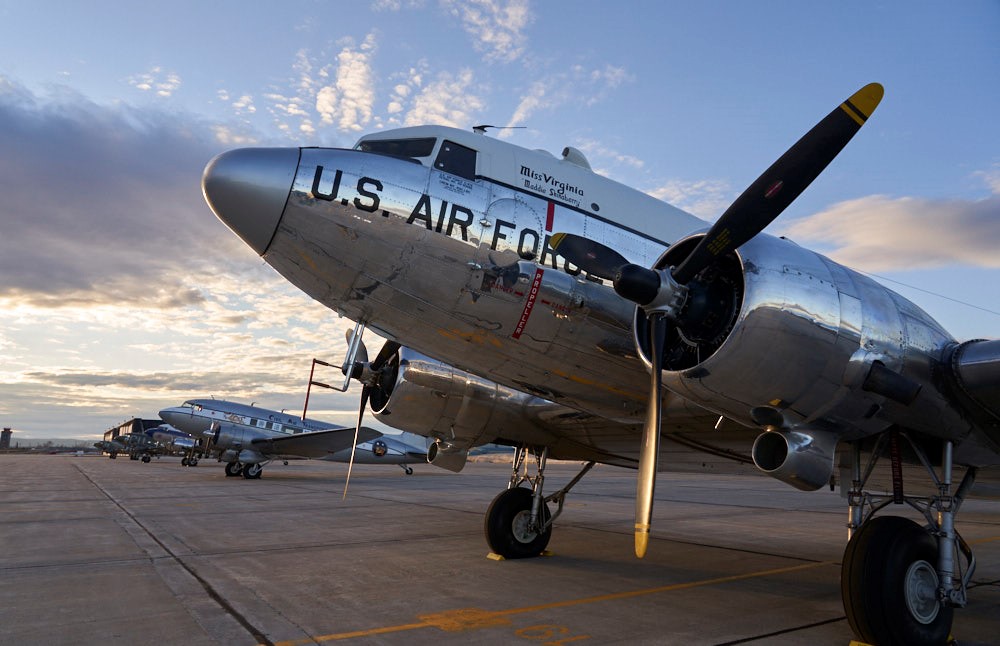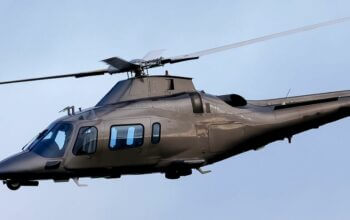Estimated reading time 10 minutes, 46 seconds.
The burbling rumble of twin Pratt & Whitney R-1830 Twin Wasp radials on a Douglas DC-3, firing two rows of seven air-cooled cylinders and driving three-bladed props, remains one of the most distinctive sounds in aviation.

Eighty-four years after the aircraft’s first flight, hundreds of DC-3s remain in commercial service in far-flung places, but for many enthusiasts that characteristic sound can only be heard from vintage warbirds at airshows.
Civil production of the DC-3 ended in 1942 when the Douglas Aircraft Company (merged with McDonnell Aircraft as McDonnell Douglas in 1967, which 30 years later merged with Boeing) began cranking out militarized C-47s. Orders rolled in once air force planners noted the DC-3’s versatility, range and stability.
Tagged the Skytrain by the United States but best known as the Dakota, the C-47 revolutionized military air transport. The robust all-metal “Dak” quickly became the go-to platform for paratroop drops and other operations, the most high-profile being the Allies’ D-Day assault on the German-held beaches of Normandy, France, in June 1944.
This June 6 marks the 75th anniversary of the liberation of Western Europe from Nazi control. Officially called Operation Overlord, it saw some 156,000 British, Canadian and American forces hit the fortified coast after thousands of paratroopers had been dropped behind lines during the night from more than 800 C-47s.
Victory in Europe was declared in May 1945, but the end of the Second World War had effectively begun 11 months earlier with D-Day.
Daks over Normandy
To help celebrate its 75th anniversary, the D-Day Squadron, headquartered at Dekalb-Peachtree Airport in Atlanta, Ga., is joining in a commemorative mini-invasion of Normandy by more than 30 Daks, led by the squadron’s own “Placid Lassie.” Nineteen North American aircraft will be joined by approximately 15 from Europe.
The D-Day Squadron is the outreach arm of the Tunison Foundation, which flies the Dak and other vintage aircraft in celebration of “the service and sacrifice of the citizen soldier and their role in bringing about victory in World War II.”
From June 2 to 5, the collection of Daks will be stationed at Duxford, a fabled wartime Royal Air Force base in Cambridgeshire, which figured prominently in the Battle of Britain against the Luftwaffe in 1940. The aerodrome today is home to the Imperial War Museum Duxford and its extensive collection of historically important aircraft. Duxford described the event as “the greatest number of Douglas C-47 Skytrain and Dakota aircraft in one location” since the war. There are plans for mass parachute jumps as well as flight and static displays.
From June 5 to 9 the aircraft will be headquartered at Caen-Carpiquet Airport in Normandy, a short drive from some of northern France’s famous beaches.
Some participants in the friendly invasion of Normandy, having begun their journey from Oxford, Conn., and doing a Hudson River flyover at New York City, stopped over at Canadian Forces Base Goose Bay in Labrador before transiting Greenland, Iceland and Scotland.

The first U.S. aircraft, “Clipper Tabitha May,” sporting vintage Pan American World Airways livery, arrived at Duxford May 21. The others flew in groups, including five that were delayed at Goose Bay for two days, for logistical reasons. For example, the facilities in Greenland could only refuel about one aircraft per hour.
“The C-47/DC-3 airplanes are not swift,” explained Eric Zipkin, the event’s U.S. co-ordinator, during a pre-departure briefing. “We are down at low altitude and in the weather for a significant period of time, so finding our weather window . . . is probably the biggest challenge.”
Another is fuel. “Each one of those airplanes burns about 100 gallons of avgas per hour; each aircraft has a crew of between five and 10 people; and each aircraft is consuming at least a gallon of oil per hour. We’re talking about literally thousands . . . of gallons of fuel, hundreds of thousands of dollars.”
Zipkin said moving the aircraft and simply housing and feeding crews at the various stopovers is “an enormous logistical project.”
The D-Day Squadron’s aerial co-ordinator is Andy Magg, a member of the Wisconsin-based Commemorative Air Force, which flies “That’s All, Brother”–a message to Adolf Hitler. It actually led the 1944 D-Day mission and participated in several other major Second World War missions before passing through 16 civilian owners. It was recovered from an aircraft boneyard, where it was scheduled within weeks to be remanufactured as a turboprop, but fund-raising enabled its resurrection.
Magg said “That’s All, Brother” has only been flying for about a year. “It didn’t have the correct paint job, none of the interior was fitted out and . . .we wanted to give it the full treatment to honour all the veterans.”
He also said that the squadron’s crews, who would be flying hundreds of kilometres over the frigid North Atlantic, had taken survival training by the Federal Aviation Administration in Oklahoma City. “You actually get in the water and into life rafts and that sort of stuff. The only thing they don’t simulate? That water is about 85 degrees; you could take a bath in it.” The crews were trusting the C-47’s ability to fly “really great on one engine” and keep them from having to ditch in the much colder ocean water.
Nonetheless, learning to fly and even taxi the C-47 has tested many pilots trained on more modern aircraft. And gaining enough experience for the D-Day journey involved many hours logged and dollars spent by pilots with day jobs.
As for actually flying the Dak, Magg quoted “an old navy saying that big boats turn slowly.” Formation flying means “you have to plan very far ahead so that if you’re out of position and adding power . . . you need to back off power very early before you’re in position. You’re always having to think two steps ahead of the plane just because you have a lot of mass.”

That said, he added, “the wonderful thing about the C-47, it’s a very stable plane. One of the things it does very well is go straight and level and allow the formation work . . . You don’t do a lot of intensive manoeuvring in some lighter trainers or fighters.”
Zipkin noted that one of his partners in the briefing, Dave Hamilton, had not only flown a C-47 on D-Day as a “tip of the spear” Pathfinder pilot but he had also, as required of aircraft commanders at the time, done a practice parachute drop with the 18 troops he would ferry into combat.
Twenty-one at the time, Hamilton pointed out that the northern route to the 75th anniversary differed significantly from the southern one he flew when getting his aircraft to England during the war. That took him and his crew, flying with internal tanks, from Florida, through Puerto Rico, British Guyana, Belem and Natal in Brazil, and across the southern Atlantic to Ascension Island, from where they flew to England via Ghana, Liberia, Senegal and Morocco. It took five weeks and “was quite an adventure.”
When he did fly the D-Day mission, he recalled looking down at the Channel and seeing the sea so packed with troop carriers, equipment transports and other ships that it looked like “it had the measles” and “you could almost walk from England to France.”
A couple of months and several other missions later, he participated in Operation Dragoon, the Allied invasion of southern France in August. More than once he returned to base with lots of bullet holes in his aircraft; there also was a very near miss with a French church steeple. “It was a very exciting time,” he said. “I’m very honoured to have been there and to have lived through it.”
After the war, Hamilton kept flying C-47s in transport roles before returning to combat in the Korean War, where he first flew Douglas RB26 Invaders, a “wonderful” fast fighter-bomber.
He flew more than 50 missions in seven months before training on jets, the Lockheed F-80 Shooting Star and North American F-86 Sabre.
“The first two weeks were a little bit shocking,” he said. “My instructor laughed; he said ‘Hamilton keeps looking for that fan out front.’ ” He eventually flew with the 329th Fighter Squadron out of Stewart AFB in Newburgh, N.Y. When the squadron transitioned to Lockheed F-104s, Hamilton moved to a desk job as a staff officer. “That was quite a letdown.”
Asked to explain his longevity, Hamilton, now in his 90s and wearing his Second World War uniform for the video briefing, replied: “very good genes and the bad aims of a lot of anti-aircraft guns.”
For more information, visit daksovernormandy.com.








